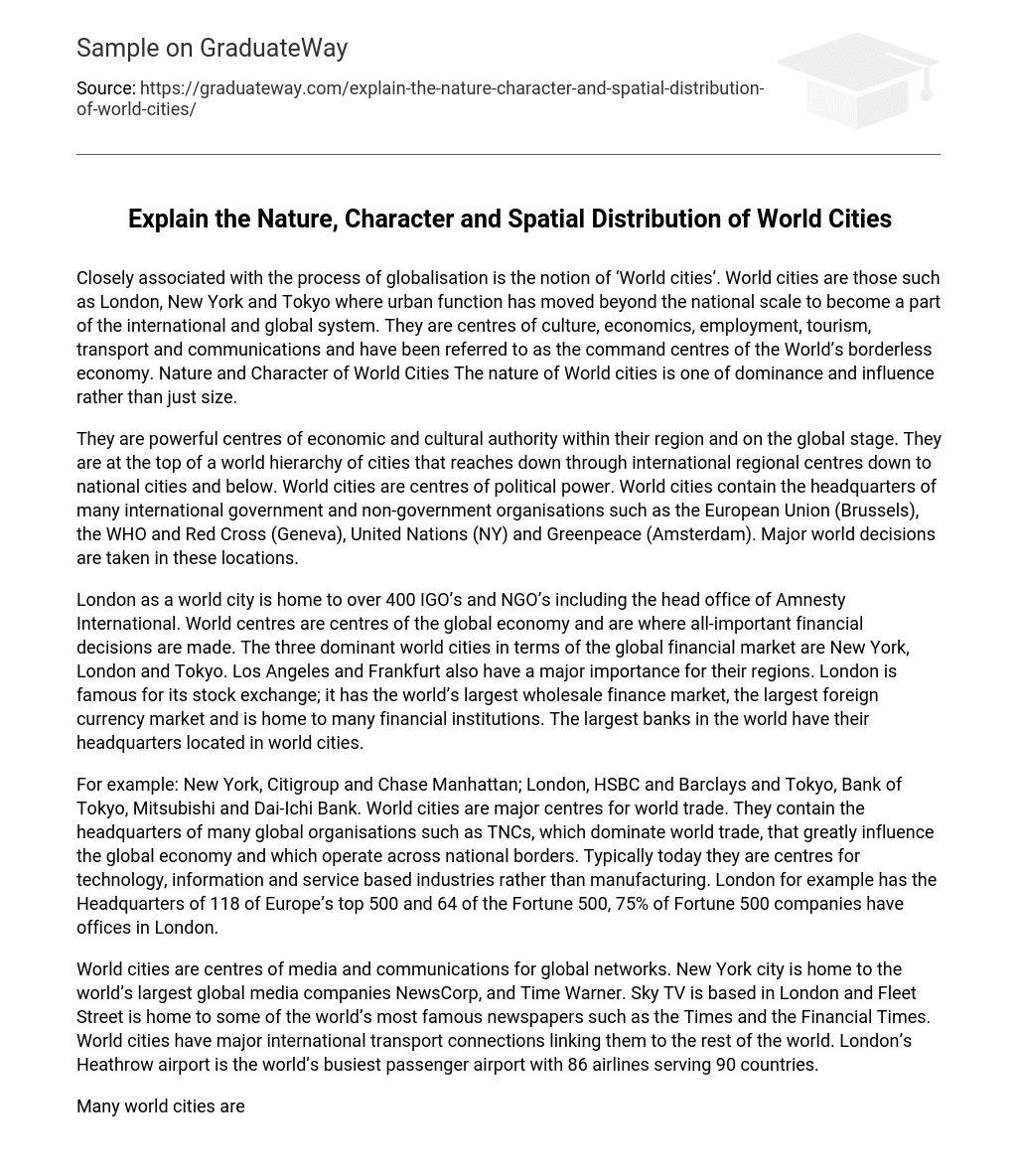The idea of ‘World cities’ is closely linked to globalization. These urban areas, like London, New York, and Tokyo, have surpassed national boundaries to become vital components of the international and global system. They serve as hubs for cultural, economic, employment, tourism, transport, and communication activities. Consequently, they are commonly referred to as the command centers of the global economy. What distinguishes World cities is their dominance and impact rather than solely their size.
World cities hold immense economic and cultural influence in their respective regions and globally. They are at the apex of a global hierarchy of cities that includes international regional centers, national cities, and more. Furthermore, these cities possess substantial political power due to hosting the headquarters of various international government and non-government organizations. Examples include Brussels housing the European Union, Geneva accommodating WHO and Red Cross, New York being home to the United Nations, and Amsterdam serving as Greenpeace’s base. As a result, crucial global decisions are made within these world cities.
London, New York, and Tokyo are renowned global financial cities. London is specifically recognized for its stock exchange and holds the largest wholesale finance market along with the largest foreign currency market globally. It hosts more than 400 IGO’s and NGO’s, including Amnesty International’s headquarters. Los Angeles and Frankfurt also possess significant significance in their respective regions, housing numerous financial institutions and major bank headquarters.
World cities such as New York, London, and Tokyo are major centers for world trade, housing the headquarters of various global organizations. In New York, Citigroup and Chase Manhattan are headquartered there, while in London HSBC and Barclays have their headquarters. Tokyo is home to Bank of Tokyo, Mitsubishi, and Dai-Ichi Bank.
These transnational corporations (TNCs) dominate global trade and have a significant impact on the global economy due to their international operations.
In addition to their role in global trade, world cities are known for their technology, information, and service-based industries rather than manufacturing. London is particularly notable with 118 of Europe’s top 500 companies’ headquarters located there along with 64 Fortune 500 companies’ headquarters. It is worth mentioning that 75% of Fortune 500 companies have offices based in London.
Global media and communication networks are significantly influenced by world cities. New York City, for example, accommodates renowned global media companies like NewsCorp and Time Warner. Likewise, London serves as the headquarters for Sky TV and is famous for its newspapers situated on Fleet Street, namely the Times and the Financial Times. Additionally, both cities possess extensive international transportation connections. It is important to mention that Heathrow airport in London holds the record for being the busiest passenger airport worldwide with services offered to 90 countries through 86 airlines.
Many global cities, including Tokyo and New York, serve as important international ports and hubs of cultural influence in various domains such as sports, fashion, and the arts. Paris, New York, Milan, and London are particularly renowned for their contributions to the fashion industry. What sets London apart is its housing of celebrated designers like Stella McCartney, Burberry, and Alexander McQueen. It also provides globally acclaimed shopping experiences at Harrods and Bond Street. Furthermore, both London’s West End and Broadway in New York feature the world’s most prestigious theatre districts. Lastly, Los Angeles thrives as a city where dominant American film culture flourishes.
Paris is famous for its cuisine, while Tokyo has the highest number of Michelin starred restaurants compared to any other city worldwide. London is prominent in sports, with iconic venues including Wembley (football), Wimbledon (tennis), and Twickenham (rugby). Additionally, London hosted the 2012 Olympic games. World cities have distinct and esteemed ways of life that attract visitors from all over the world. These cities also serve as tourist hubs and melting pots for various cultures and expatriate communities. It is worth noting that London attracts the largest number of tourists globally, solidifying its status as the most visited city in the world.
World cities are renowned for their historical, cultural, and scenic attractions that attract both tourists and expats. These cities offer a vibrant urban lifestyle where individuals from different backgrounds can participate in a wide range of experiences. World cities are celebrated for their multiculturalism, energy, creativity, trend-setting abilities, and connectivity. They can be classified into three groups based on their spatial distribution: dominant cities, major cities, and secondary cities. Dominant cities such as London, Paris, New York, and Tokyo have significant global economic influence.
Major world cities, like Zurich, Frankfurt, and Amsterdam, connect large national economies and the global system. Secondary world cities, such as Sydney, Milan, and Chicago, link their regions to the global economy. These world cities are distributed across various time zones and locations globally in order to facilitate the integration of national and regional economies into the global network. The majority of these cities are situated in the northern hemisphere. In terms of geography, Western Europe boasts the greatest concentration with around 12 world cities including London, Rome, and Berlin.
The USA has 8 world cities, including New York, Los Angeles, and Houston. Asia has about 7 world cities, such as Tokyo, Singapore, and Hong Kong. In the southern hemisphere, there are only 4 world cities: Sydney and Buenos Aires. These cities are considered secondary world cities. Johannesburg is Africa’s sole world city, indicating Africa’s marginalization in the global economy. Developing countries have a limited number of world cities because a city’s classification as a “world city” depends on its global role and connections rather than just its population size.





